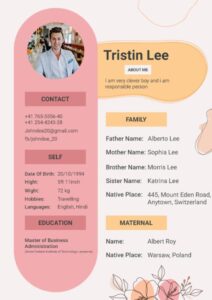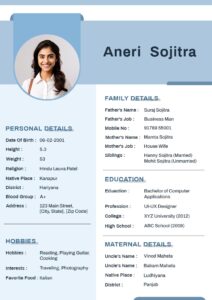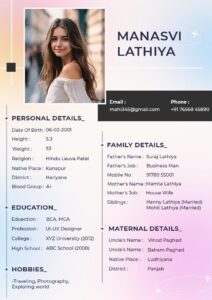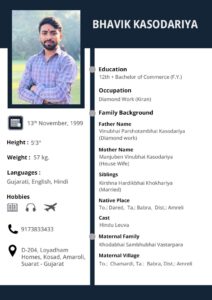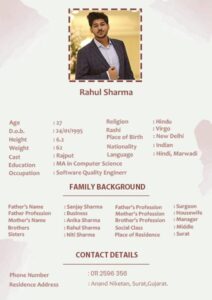A Complete Guide the Perfect Biodata for Marriage
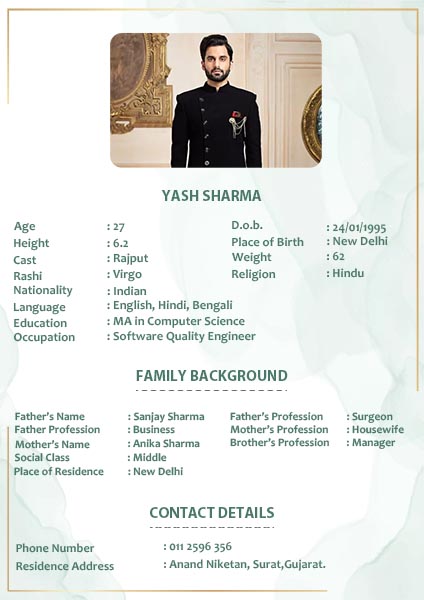
In many cultures, especially in India, creating a biodata for marriage is a traditional and crucial step in the process of finding a suitable life partner. A marriage biodata is essentially a detailed resume that highlights an individual’s personal, educational, and family background, along with other pertinent information that potential partners and their families would consider important. This article provides a comprehensive guide on how to create an impressive and effective biodata for marriage.
What is a Biodata for Marriage?
Definition and Purpose
A biodata for marriage is a document that provides a structured overview of an individual’s life, character, and preferences, specifically tailored for matrimonial purposes. Unlike a professional resume, which focuses on career achievements, a marriage biodata includes personal details, family background, religious beliefs, and other information that is relevant in the context of marriage.
- Personal Information: Includes basic details such as name, age, date of birth, and contact information.
- Educational Background: Details about academic qualifications and professional achievements.
- Family Background: Information about parents, siblings, and their occupations.
- Personal Preferences: Hobbies, interests, and preferences in a life partner.
- Religious and Cultural Beliefs: Information about religious practices, community affiliations, and cultural values.
Why is a Biodata Important in Arranged Marriages?
Cultural Significance
In cultures where arranged marriages are common, a biodata for marriage is the first impression that a potential partner and their family get about an individual. It plays a crucial role in determining compatibility between two individuals and their families, making it a significant step in the matchmaking process.
- Compatibility Check: Helps families assess compatibility in terms of values, lifestyle, and future expectations.
- Family Expectations: Provides insight into family background, which is often a key consideration in arranged marriages.
- Cultural Alignment: Ensures that both families share similar cultural and religious beliefs, which is important for long-term harmony.
Key Components of a Marriage Biodata
1. Personal Details
The personal details section should include your full name, age, date of birth, height, weight, and physical appearance. It’s also important to mention your contact information, including phone number and email address, for easy communication.
- Name: Full name as per legal documents.
- Date of Birth: Include your date of birth for astrological matching if required.
- Height and Weight: Mention your height and weight as these are common criteria in marriage considerations.
- Physical Appearance: Include a brief description of your physical features, such as complexion and build.
- Contact Information: Provide a phone number and email address for further communication.
2. Educational Background
This section should detail your academic qualifications, including the names of the institutions you attended, the degrees you obtained, and any significant achievements. It’s also useful to mention any professional certifications or courses that add value to your profile.
- Academic Qualifications: List your degrees in chronological order, starting from the most recent.
- Institutions Attended: Mention the names of the schools, colleges, and universities you attended.
- Professional Certifications: Include any additional certifications or diplomas relevant to your career.
3. Professional Background
Your professional background should include your current job title, the company you work for, your work experience, and your future career aspirations. This gives potential partners insight into your professional stability and ambitions.
- Current Job Title: Mention your current role and the company you work for.
- Work Experience: Provide a brief overview of your work history, highlighting key roles and responsibilities.
- Career Aspirations: Share your future career goals and how you plan to achieve them.
4. Family Background
The family background section is particularly important in arranged marriages. Include information about your parents, their professions, and any siblings. If applicable, mention the family’s cultural or religious affiliations, as well as any significant family achievements.
- Parents’ Occupation: Mention your parents’ professions and any significant achievements.
- Siblings: Provide details about your siblings, including their occupations and marital status.
- Cultural and Religious Affiliations: Include information about your family’s cultural and religious practices.
5. Religious and Cultural Beliefs
In this section, detail your religious beliefs, practices, and any community involvement. This is crucial for ensuring compatibility in terms of spiritual and cultural values.
- Religious Practices: Mention the religious practices you follow regularly.
- Community Involvement: Include any involvement in community activities or religious organizations.
- Cultural Values: Share any cultural beliefs or values that are important to you and your family.
6. Hobbies and Interests
Including your hobbies and interests gives potential partners a glimpse into your personality and lifestyle. This section should be brief but should highlight any significant hobbies or passions you have.
- Hobbies: Mention hobbies that you regularly engage in, such as reading, sports, or traveling.
- Interests: Include any specific interests or activities you are passionate about, such as music, cooking, or art.
7. Expectations in a Life Partner
This section should clearly outline your expectations for a life partner, including qualities you value, lifestyle preferences, and any specific requirements you have. Be honest but considerate in this section to attract compatible matches.
- Qualities: Mention the qualities you seek in a partner, such as honesty, kindness, or ambition.
- Lifestyle Preferences: Share your preferences regarding lifestyle choices, such as career focus, family orientation, or social habits.
- Specific Requirements: If you have any specific requirements, such as dietary habits or educational background, mention them here.
Click Here : invitation of satyanarayan pooja
How to Write an Effective Biodata for Marriage
1. Be Honest and Clear
Honesty is crucial when creating a biodata for marriage. Misrepresenting information can lead to complications later on. Be clear and concise in your descriptions, providing accurate details that reflect who you are.
- Accurate Information: Ensure all the information provided is accurate and up-to-date.
- Clear Language: Use simple and clear language to convey your details effectively.
2. Keep it Concise
While it’s important to include all relevant information, your biodata should be concise and to the point. Avoid lengthy paragraphs and focus on the key details that matter most to potential partners.
- Brevity: Keep descriptions short and to the point, avoiding unnecessary details.
- Bullet Points: Use bullet points for lists to make the biodata easy to read.
3. Use a Professional Format
The format of your biodata for marriage should be professional and organized. Use headings and subheadings to structure the information logically, and ensure the document is visually appealing.
- Organized Layout: Use headings and subheadings to organize the information.
- Professional Design: Choose a clean, professional design that enhances readability.
4. Include a Recent Photograph
A recent photograph is an important part of a marriage biodata. Choose a clear, professional-looking photograph that presents you in a positive light. Avoid overly casual or edited photos.
- Professional Appearance: Choose a photograph that is clear and professional.
- Recent Photo: Ensure the photo is recent and accurately represents your current appearance.
5. Customize According to Cultural Norms
Different cultures have different expectations when it comes to marriage biodata. Customize your biodata to reflect the cultural norms and values that are important to you and your family.
- Cultural Relevance: Ensure the biodata reflects the cultural norms of your community.
- Tailored Content: Customize the content to highlight culturally significant details.
Common Mistakes to Avoid When Creating a Biodata for Marriage
1. Overloading with Information
While it’s important to be thorough, overloading your biodata with too much information can be overwhelming for the reader. Focus on the key details that matter most in the context of marriage.
- Avoiding Clutter: Stick to the most relevant information and avoid unnecessary details.
- Key Highlights: Highlight the most important aspects of your profile.
2. Being Vague or Incomplete
Vagueness or incomplete information can create confusion or lead to misunderstandings. Ensure that all sections of your biodata are complete and provide clear, specific details.
- Complete Information: Ensure all sections are filled out completely.
- Specific Details: Provide specific details rather than vague descriptions.
3. Using Casual Language
A marriage biodata is a formal document, and the language used should reflect that. Avoid using casual or colloquial language, and instead opt for a more formal tone.
- Formal Tone: Use formal language appropriate for a matrimonial document.
- Avoiding Slang: Refrain from using slang or overly casual phrases.
4. Ignoring Formatting and Presentation
The presentation of your biodata is just as important as the content. Poor formatting or a cluttered design can make a bad impression, so take the time to ensure your biodata is well-organized and visually appealing.
- Neat Formatting: Use consistent formatting throughout the document.
- Visual Appeal: Choose a design that is clean and easy to navigate.
Conclusion
Creating a biodata for marriage is a critical step in the arranged marriage process. It’s more than just a document; it’s a reflection of who you are and what you seek in a life partner. By following the guidelines in this article, you can craft a biodata that is not only informative but also engaging and reflective of your true self. Whether you are creating your biodata for the first time or updating an existing one, remember that clarity, honesty, and cultural relevance are key to making a positive impression on potential matches and their families.





